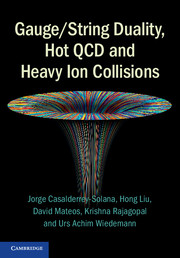Book contents
- Frontmatter
- Contents
- 1 Opening remarks
- 2 A heavy ion phenomenology primer
- 3 Results from lattice QCD at nonzero temperature
- 4 Introducing the gauge/string duality
- 5 A duality toolbox
- 6 Bulk properties of strongly coupled plasma
- 7 From hydrodynamics to far-from-equilibrium dynamics
- 8 Probing strongly coupled plasma
- 9 Quarkonium mesons in strongly coupled plasma
- 10 Concluding remarks and outlook
- Appendix A Green–Kubo formula for transport coefficients
- Appendix B Hawking temperature of a general black brane metric
- Appendix C Holographic renormalization, one-point functions, and a two-point function
- Appendix D Computation of the holographic stress tensor
- References
- Index
9 - Quarkonium mesons in strongly coupled plasma
Published online by Cambridge University Press: 05 July 2014
- Frontmatter
- Contents
- 1 Opening remarks
- 2 A heavy ion phenomenology primer
- 3 Results from lattice QCD at nonzero temperature
- 4 Introducing the gauge/string duality
- 5 A duality toolbox
- 6 Bulk properties of strongly coupled plasma
- 7 From hydrodynamics to far-from-equilibrium dynamics
- 8 Probing strongly coupled plasma
- 9 Quarkonium mesons in strongly coupled plasma
- 10 Concluding remarks and outlook
- Appendix A Green–Kubo formula for transport coefficients
- Appendix B Hawking temperature of a general black brane metric
- Appendix C Holographic renormalization, one-point functions, and a two-point function
- Appendix D Computation of the holographic stress tensor
- References
- Index
Summary
As discussed in Section 2.4, heavy quarks and quarkonium mesons, with masses such that M/T ≫ 1, constitute valuable probes of the QGP. Since dynamical questions about these probes are very hard to answer from first principles, here we will study analogous questions in the strongly coupled N = 4 SYM plasma. In this case the gauge/string duality provides the tool that makes a theoretical treatment possible. Although for concreteness we will focus on the N = 4 plasma, many of the results that we will obtain are rather universal in the sense that, at least qualitatively, they hold for any strongly coupled gauge theory with a string dual. Such results may give us insights relevant for the QCD quark–gluon plasma at temperatures at which it is reasonably strongly coupled.
The QGP only exists at temperatures T > Tc, so in QCD the condition M/T ≫ 1 can only be realized by taking M to be large. In contrast, N = 4 SYM is a conformal theory with no confining phase, so all temperatures are equivalent. In the presence of an additional scale, namely the quark or the meson mass, the physics only depends on the ratio M/T. This means that in the N = 4 theory the condition M/T ≫ 1 can be realized by fixing T and sending M to infinity, or by fixing M and sending T → 0; both limits are completely equivalent. In particular, the leading order approximation to the heavy quark or quarkonium meson physics, in an expansion in T/M, may be obtained by setting T = 0. For this reason, this is the limit that we will study first.
- Type
- Chapter
- Information
- Gauge/String Duality, Hot QCD and Heavy Ion Collisions , pp. 347 - 397Publisher: Cambridge University PressPrint publication year: 2014

